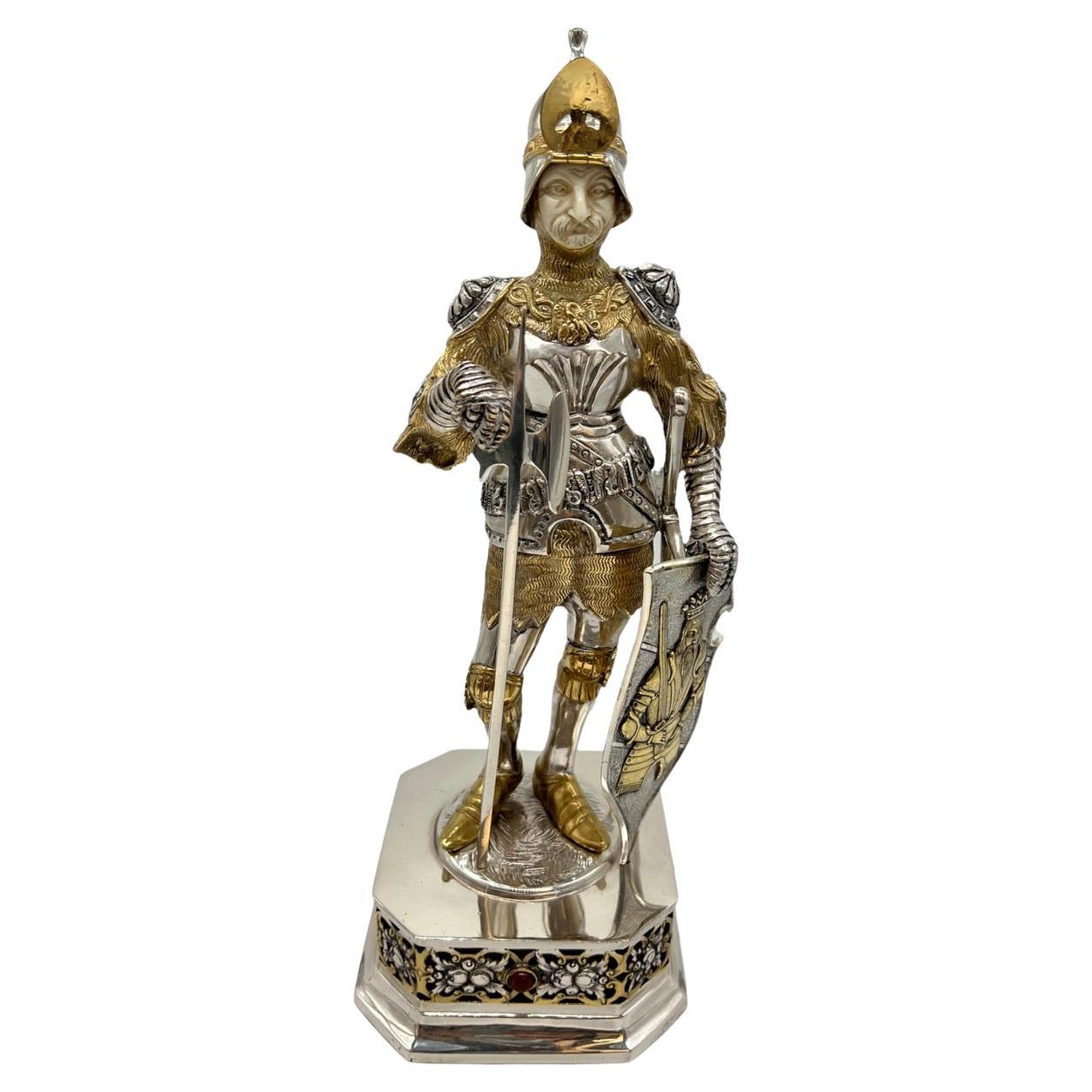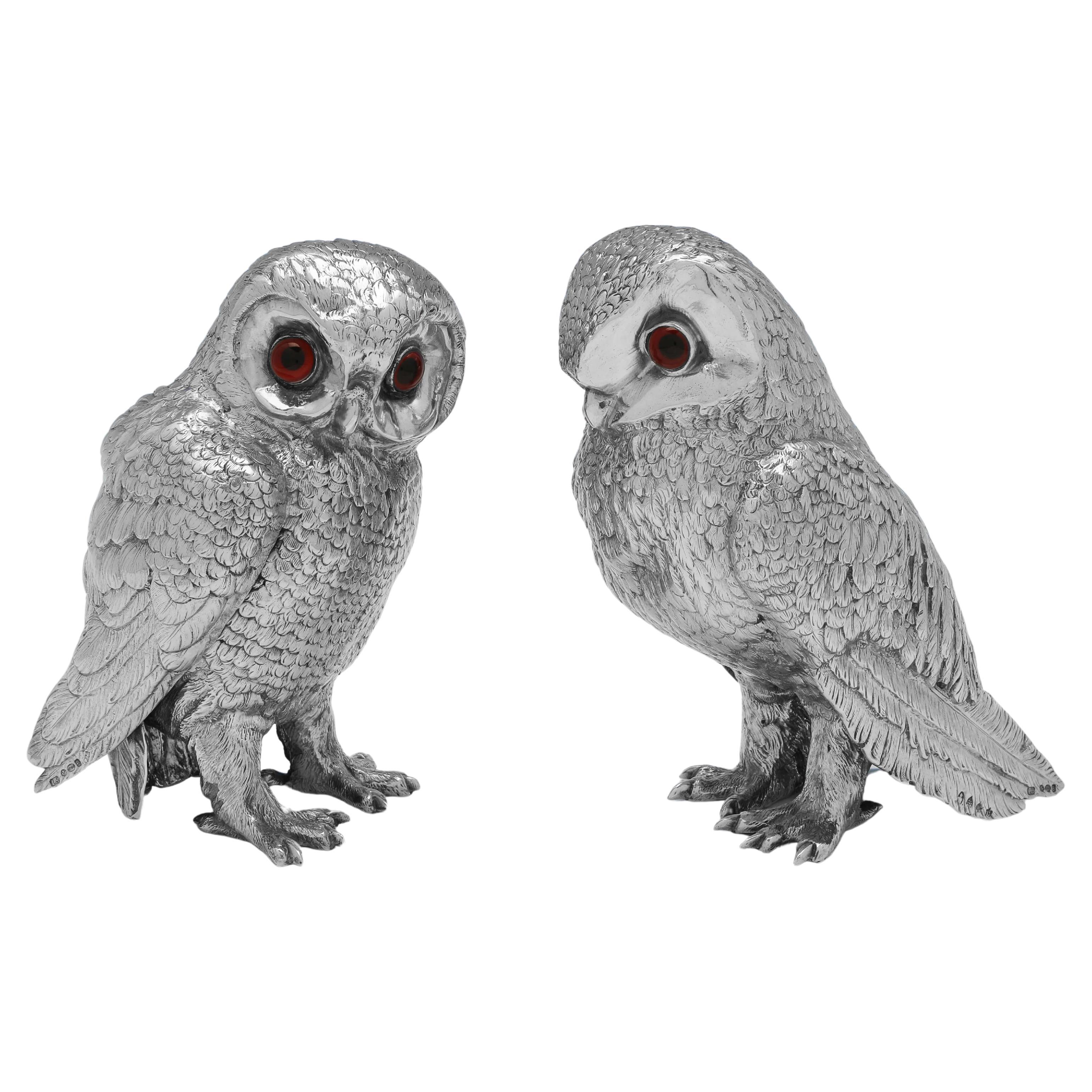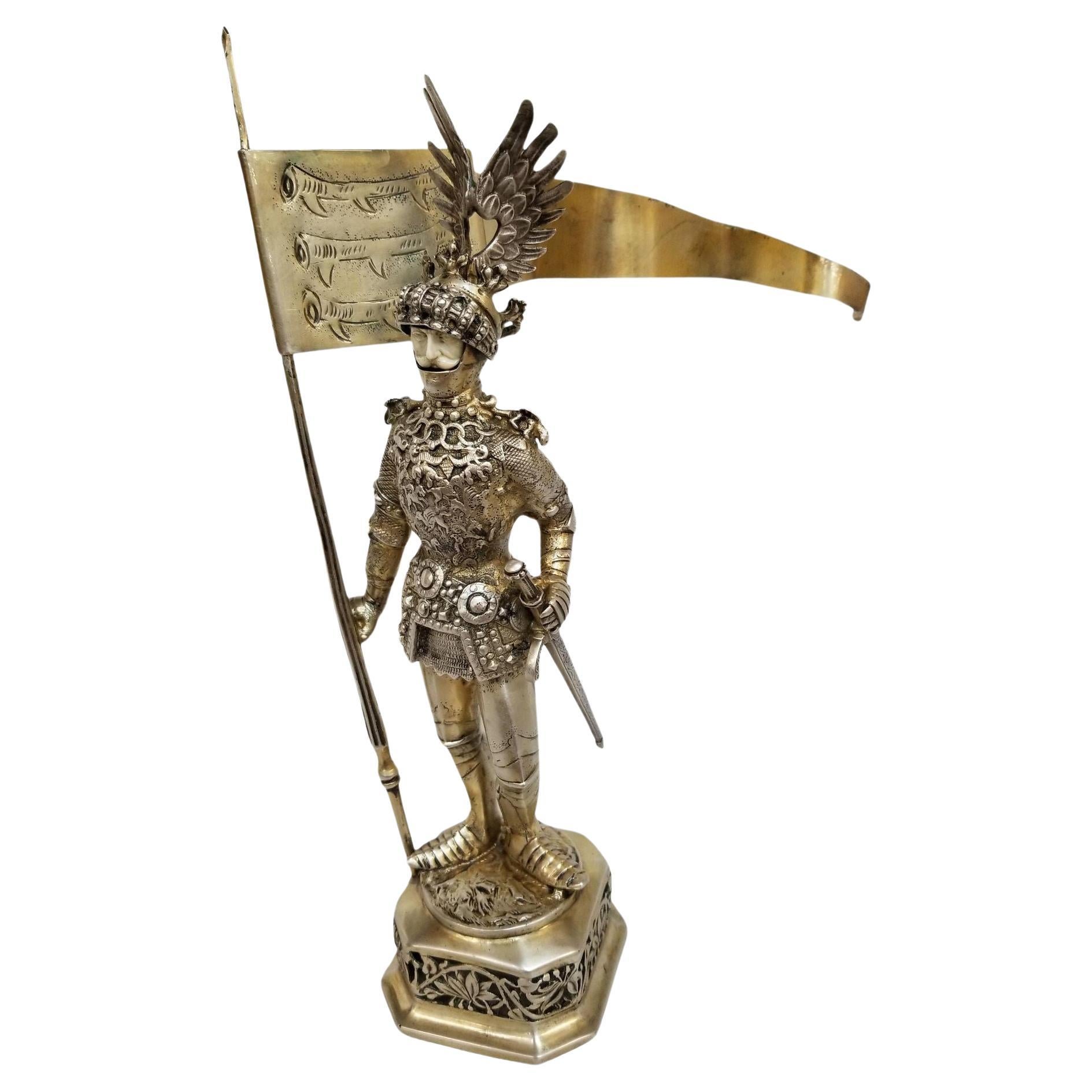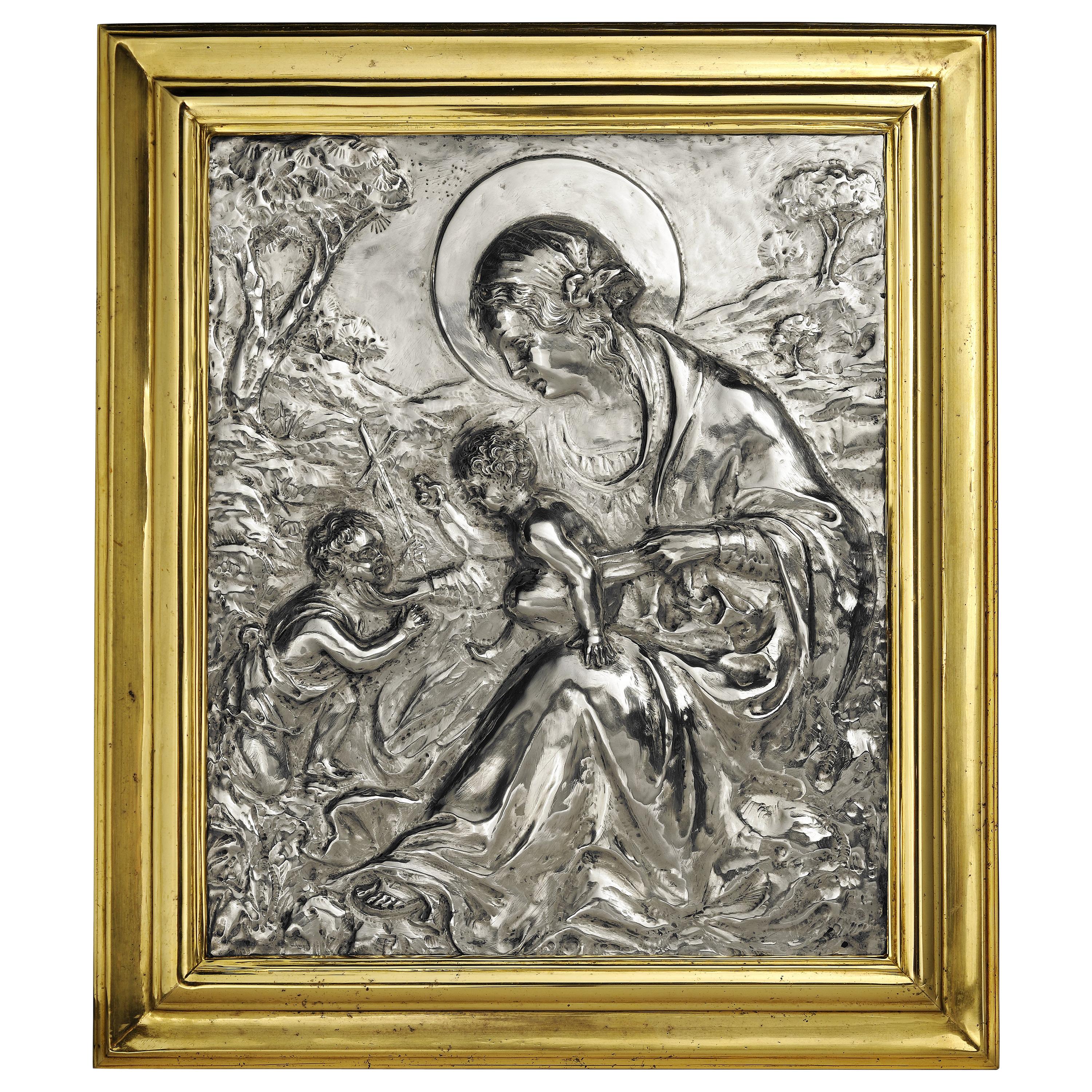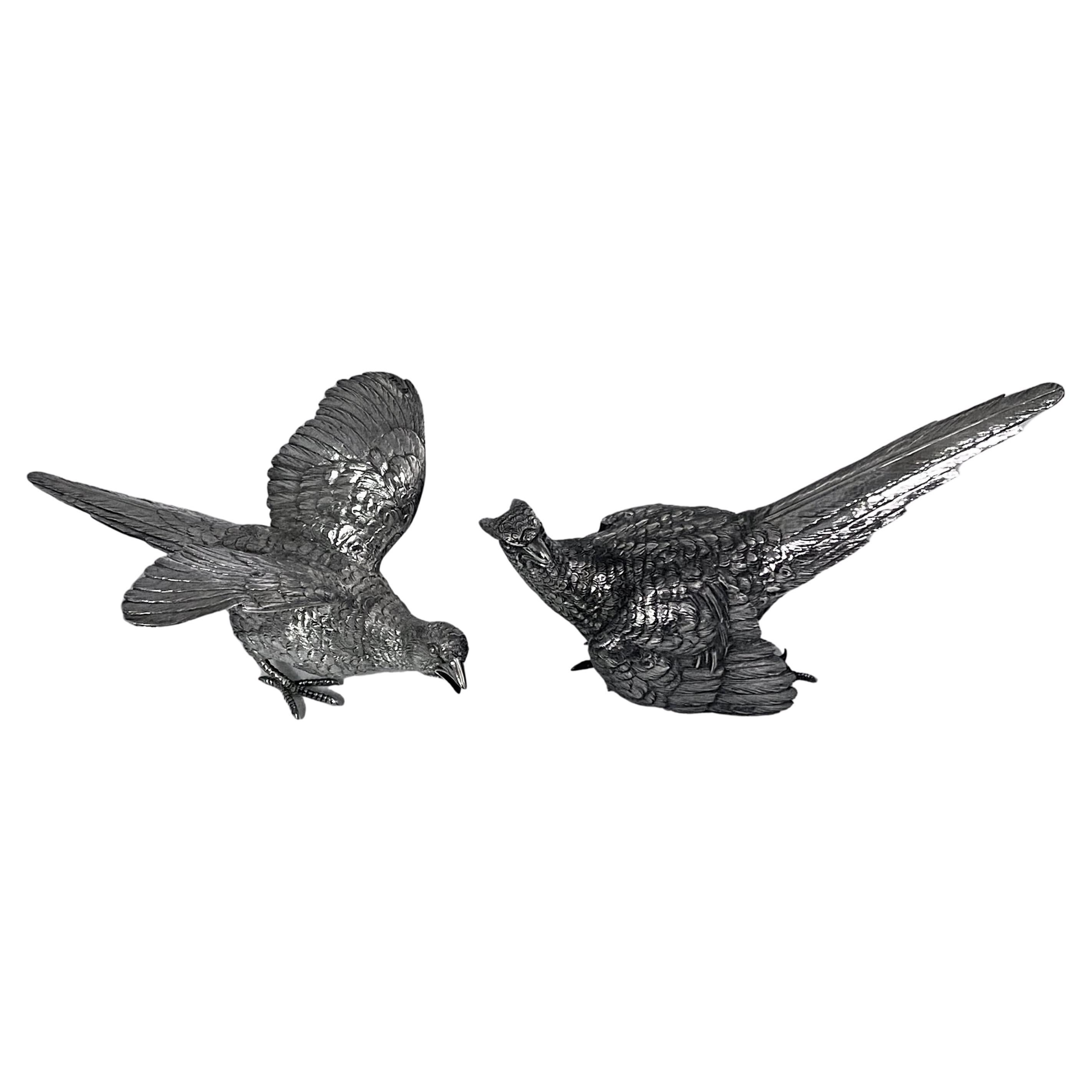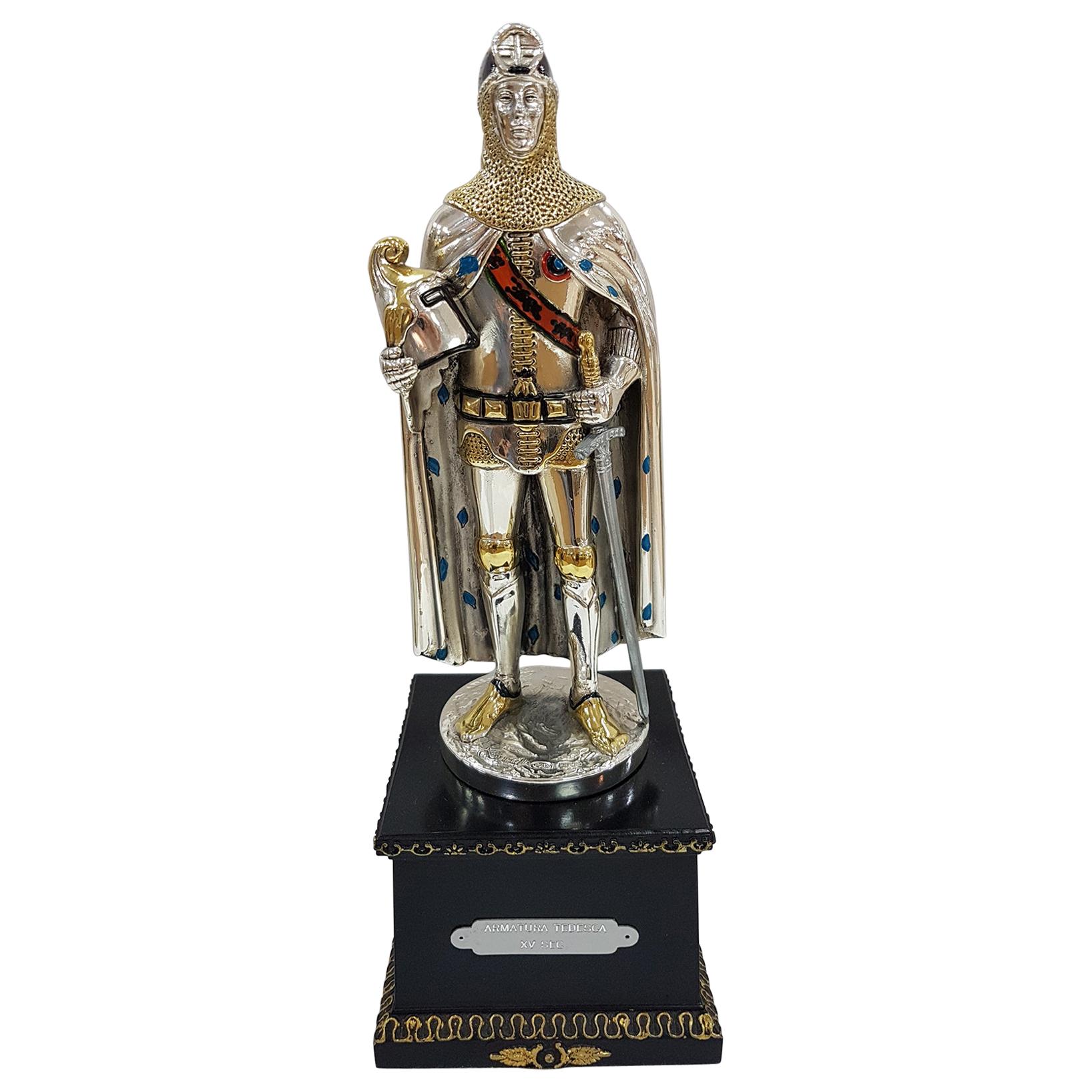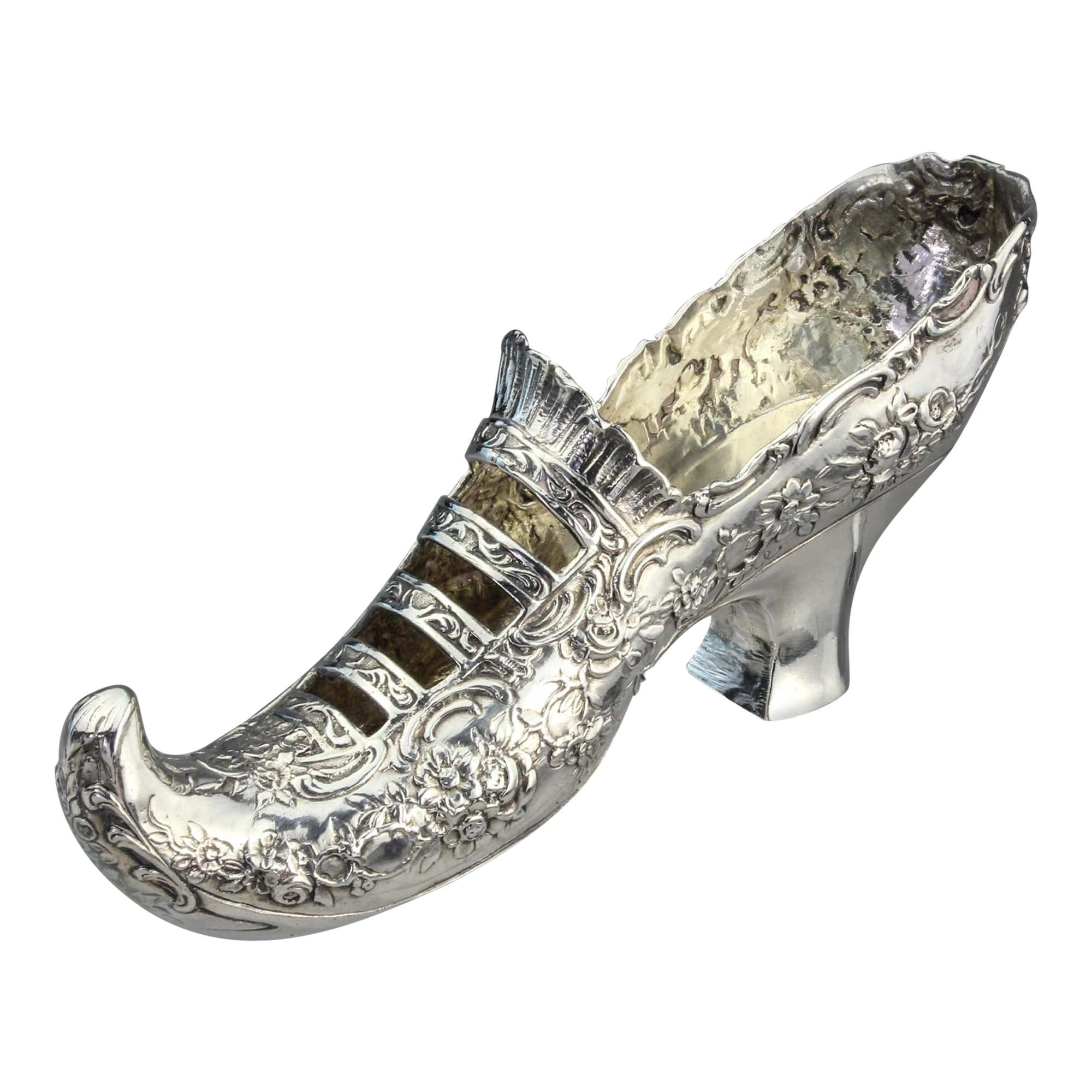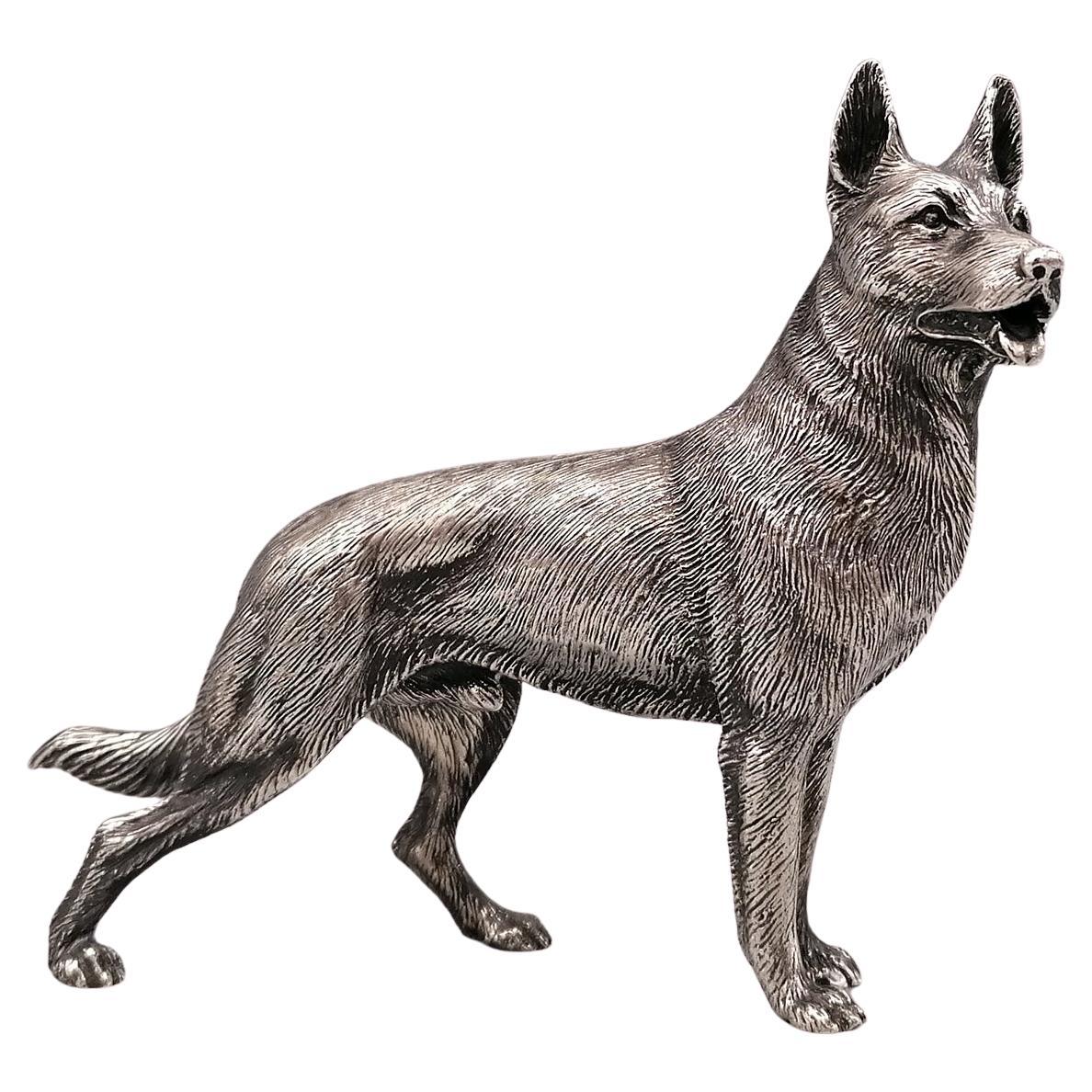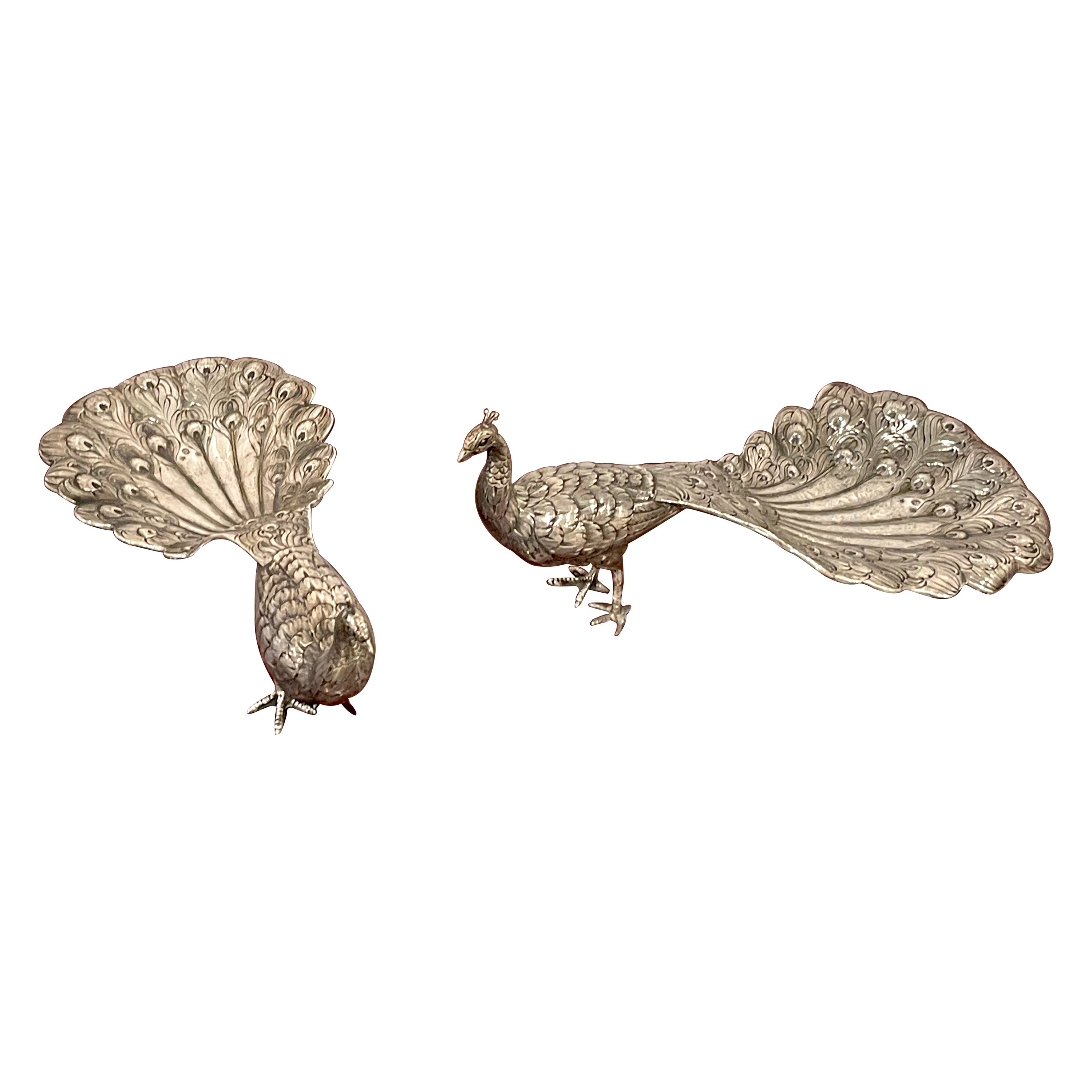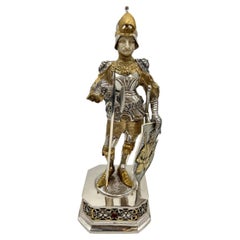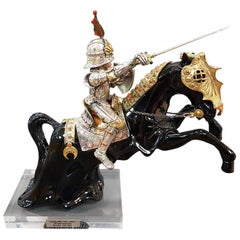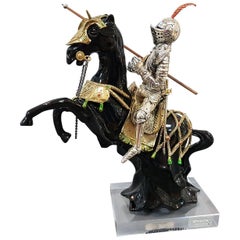
German 19th Century Sterling & Vermeil Silver Knights Probably Neresheimer, Pair
View Similar Items
Want more images or videos?
Request additional images or videos from the seller
1 of 21
German 19th Century Sterling & Vermeil Silver Knights Probably Neresheimer, Pair
About the Item
- Attributed to:Ludwig Neresheimer (Workshop/Studio)
- Dimensions:Height: 22.13 in (56.22 cm)Width: 11.75 in (29.85 cm)Depth: 8.75 in (22.23 cm)
- Sold As:Set of 2
- Style:Medieval (In the Style Of)
- Materials and Techniques:
- Place of Origin:
- Period:
- Date of Manufacture:circa 1890-1900
- Condition:Wear consistent with age and use. Minor fading. A truly stunning quality and rare pair of large sterling silver sculptures. Fine attention to each and every detail. Overall condition is excellent with no damage. Minor age scratches and wear as expected. Just FANTASTIC! Please view all images.
- Seller Location:Los Angeles, CA
- Reference Number:Seller: Ref.: A19191stDibs: LU1796211420771
About the Seller
5.0
Vetted Seller
These experienced sellers undergo a comprehensive evaluation by our team of in-house experts.
Established in 1982
1stDibs seller since 2016
113 sales on 1stDibs
More From This SellerView All
- Cipri Adolf Bermann, German, 19th Century Gilt-Bronze Bacchus Herm TermBy Cipri Adolf BermannLocated in Los Angeles, CACipri Adolf Bermann (German, 1862-1942) a very fine 19th century gilt-bronze miniature figure of a Bacchus Herm, depicting Bacchus, also known as Dionysus, the god of the grape harve...Category
Antique Early 1900s German Louis XV Figurative Sculptures
MaterialsMarble, Bronze
$2,850 Sale Price42% Off - Early 20th Century Five-Piece Louis XV Style Sterling Silver Tea and Coffee SetLocated in Los Angeles, CAA very fine early 20th century five-piece Louis XV style sterling silver tea and coffee service set. The finely chased ovoid shaped ...Category
Early 20th Century Argentine Louis XV Tea Sets
MaterialsSilver
$6,495 Sale Price / set47% Off - Monumental Pair of French 19th-20th Century Putto Flambeaux Urns TorcheresBy René Rozet 1Located in Los Angeles, CAMonumental pair of French 19th century figural gilt and patinated bronze Rosso Granite marble Flambeaux Urns Torcheres, each depicting a pair of allegorical Putti (Children) holding ...Category
Antique 1890s French Louis XV Figurative Sculptures
MaterialsGranite, Bronze
- Charming Pair of Austrian 19th Century Polychromed Majolica Wall SculpturesBy Friedrich GoldscheiderLocated in Los Angeles, CAA fine and charming pair of Austrian 19th century polychromed majolica hanging wall sculptures of an elderly couple peeking through a window, probably by Friedrich Goldscheider (Goldscheider'sche Porzellan-Manufactur und Majolica-Fabrik.) Each wall sculpture depicting an elderly man wearing glasses and a traditional cap with his arms extended forward as if it was reading a book or a newspaper. The other depicting an elderly lady, also peeking through a window, wearing a laced cap with a bow tie and shawl over her shoulders, her arms are also extended forward as if it was reading a book or a newspaper. The male figure stamped on the back "78 - II ." The lady figure stamped on the back "37 - 79." Vienna, circa 1890-1900. Man's height: 16 1/2 inches (41.9 cm.) Man's width: 13 3/4 inches (34.9 cm.) Depth: 8 1/2 inches (21.6 cm.) Lady's height: 15 1/2 inches (39.4 cm.) Lady's width: 13 3/4 inches (34.9 cm.) Lady's depth: 6 1/2 inches (16.5 cm.) Goldscheider Manufactory and Majolica Factory (German: Goldscheider'sche Porzellan-Manufactur und Majolica-Fabrik, (now) Goldscheider Keramik) is an Austrian ceramic manufactory. In 1885, Friedrich Goldscheider came from the small Bohemian city of Pilsen to Vienna and founded the Goldscheider Manufactory and Majolica Factory. It became one of the most influential ceramic manufactories of terracotta, faience and bronze objects in Austria with subsidiaries in Paris, Leipzig and Florence. For over half a century Goldscheider created masterpieces of historical revivalism, Art Nouveau (Jugendstil) and Art Deco. Famous artists such as Josef Lorenzl, Stefan Dakon, Ida Meisinger and the two perhaps best known Austrian ceramic artists Michael Powolny and Vally Wieselthier worked for Goldscheider. Several of the artists who worked for Goldscheider also worked for other Viennese studios, such as Augarten, Keramos or for the German brands Rosenthal and Meissen. The Goldscheider family emigrated in 1938 to United Kingdom and USA. Walter Goldscheider startet a new factory in Trenton, New Jersey and returned to Vienna in 1950. Marcel Goldscheider went to Stoke-on-Trent and produced figurative ceramics for Myott and opened his own studio in the 1950s in Hanley. Both brothers died in the early 1960s. More than 10,000 different models were created over a period of three generations. Since the very beginning many of these won first prizes and gold medals at innumerable world fairs, exhibitions and trade fairs. Goldscheider figures...Category
Antique Late 19th Century Austrian Baroque Figurative Sculptures
MaterialsMajolica
$4,985 Sale Price / set47% Off - 19th Century Neoclassical Silvered Muses Centerpiece in the Manner of ChristofleBy ChristofleLocated in Los Angeles, CAA very fine French 19th century neoclassical style silver-plated figural centerpiece, in the manner of Christofle and a design by Mathurin Moreau (French, 1822-1912). The circular or...Category
Antique Early 1900s French Neoclassical Revival Centerpieces
MaterialsBronze
$4,950 Sale Price61% Off - Pair of French 19th-20th Century Neoclassical Style Cast Iron Figural TorchèresLocated in Los Angeles, CAA very fine pair of French 19th-20th century neoclassical style patinated cast iron figural torchères by A. Durenne, Paris, each representing a figure of a standing young maiden, her arms raised forward while holding a a flaming urn gas light (Now electrified) with a frosted glass flame, each raised on a veined grey marble column stand, both cast-signed 'A. Durenne, Paris'. Antoine Durenne was an internationally renowned French art founder. He attended École Nationale Supérieure des Beaux-Arts in 1842. Durenne purchased a small foundry in Sommevoire, near the Val d'Osne, Haute-Marne, France and established The Durenne firm, circa Paris, 1900. Cast-iron had been in production during the 18th century but its inferior status to the more fashionable and delicate wrought iron had generally confined its use to architectural work. By the early 19th century, however, rapid developments of the Industrial Revolution combined with the simultaneous burgeoning of a new middle class provided the impetus for a dramatic Expansion in its application and in a short space of time a proliferation of iron foundries across Europe and America thrived on the production of everything from inkstands to railway stations. The use of cast-iron for garden ornament became particularly widespread at this time, as the possibilities for its mass-production at a fraction of the cost of bronze made it the material of choice for outdoor statuary...Category
Antique Early 1900s French Neoclassical Revival Figurative Sculptures
MaterialsMarble, Iron
$59,500 Sale Price / set30% Off
You May Also Like
- 19th Century German Extremely Detailed Sterling Silver and Gold Gilt KnightLocated in North Miami, FL19th Century German extremely detailed sterling silver and gold gilt knight figure. Knight in full suit of armour, carved face beneath a hinged visor made of white bone. The knight i...Category
Antique 19th Century German Sterling Silver
MaterialsStone, Sterling Silver
- 20th Century Made in Italy Sterling Silver Horse and Knight ArmourBy Argenteria EtruriaLocated in VALENZA, ITHorse in black lacquered resin with a sterling silver armor with Russian 14th century knight in sterling silver armor with golden and enameled details.Category
Vintage 1980s Italian Medieval Sterling Silver
MaterialsSterling Silver
- 20th Century Sterling Made in Italy Silver Horse and Knight ArmourBy Argenteria EtruriaLocated in VALENZA, ITHorse in black lacquered resin with a sterling silver armor with Italian XIV Century Knight in sterling silver armor with golden and enamelled details.Category
Vintage 1980s Italian Medieval Sterling Silver
MaterialsSterling Silver
- Rare Pair of Sterling Silver Owl Models - Import Mark 1937 - Neresheimer & SohneBy Israel Segalov, B. Neresheimer & SohneLocated in London, LondonCarrying import marks for 1937 by Israel Segalov, this very rare pair of Sterling Silver Owl Models, were originally made in Germany for the English market, by the great model making...Category
Vintage 1930s German Sterling Silver
MaterialsSterling Silver
- Sterling Silver 19th Century Knight in Shinning ArmorLocated in Van Nuys, CAThis antique sterling silver knight figurine from the 19th century is a captivating masterpiece. Dressed in full medieval armor with a staff and fl...Category
Antique 19th Century American Medieval Figurative Sculptures
MaterialsSilver
- 19th Century Italian Sterling Silver Madonna, circa 1830Located in Milano, ITEmbossed and engraved silver plaque La Madonna del lago (The Madonna of the Lake) Probably Milan, post 1824 Brass frame It measures 16.14 in x 13.85 in (41 x 35.2 cm) and it weighs 10.357 pounds (4.698 g): silver 1.31 pounds (598 g) + brass 9.03 pounds (4.100 g) State of conservation: some abrasions on the bottom. The frame is old, but not original. The plaque is made up of a sheet of embossed and engraved silver, and held in a solid brass frame. It depicts the “Madonna del lago” – “Madonna of the Lake” - (the Madonna with Child and San Giovannino) by Marco d'Oggiono (Oggiono, 1474 circa - Milan, 1524 circa), while changing only the background landscape. Almost certainly the subject reproduced in the plaque was taken from a famous engraving by Giuseppe Longhi (Monza, 1766 - Milan, 1831), one of the greatest engravers of his era. The silver is unmarked, probably because originally the Madonna was due to be exposed in a church: sometimes precious metals destined for worship and liturgical use would be exempted from payment and were, therefore, not marked. It is very likely that the plaque was made in Milan because in this city in 1824 the engraving by Giuseppe Longhi was made and printed. In addition, in Milan, the alleged lost painting by Leonardo da Vinci in his Milanese period (1482-1500) would be produced; this is the painting from which Marco d'Oggiono took his version. The painting Marco d?Oggiono was one of Leonardo da Vinci's most brilliant students and collaborators (D. Sedini, Marco d’Oggiono, tradizione e rinnovamento in Lombardia tra Quattrocento e Cinquecento, Roma 1989, pp. 151-153, n. 56; p. 225, n. 124, with previous bibliography). His style reflects in every way that of the Tuscan Maestro, so much so that he was the one who executed some copies of da Vinci's paintings. The execution of the “Madonna del Lago” probably draws inspiration from a lost painting by the Maestro, created while he was living in Milan (1482-1500). There are many similarities with other works by Leonardo such as the “Vergine delle rocce” or the “Vergine con il Bambino e San Giovannino, Sant’Anna e l’Agnello”. The painting, from which the drawing and then the famous engraving were taken, is found today at the M&G Museum of Bob Jones University in Greenville, South Carolina, where it came to rest after the sale of the Harrington Collection in London in 1917. The work appears in the inventories of the collection of Napoleon and Joséphine Bonaparte at the castle of Malmaison, before 1809. The Malmaison building was born and developed in the 17th and 18th centuries. In the 18th century it belonged to Jacques-Jean Le Coulteux du Molay, a wealthy banker. Later, during the Directory, Joséphine Bonaparte de Beauharnais bought it on April 21st, 1799, but settled at the castle definitively only after her husband separated from her in 1809. She remained there until 1814, the year of her death. When Joséphine died, the estate passed to her son Eugène de Beauharnais, who moved to Munich with his whole family in 1815, bringing with him the collection of paintings he inherited from his mother. Eugène died in 1824 and his wife Augusta of Bavaria (von Bayern), unable to keep it, in 1828 sold the Malmaison to the Swedish banker Jonas-Philip Hagerman. It is likely that in this period Augusta also sold part of the paintings inherited from her husband, including the “Madonna del Lago”. This painting then came into the possession of Leicester Stanhope, fifth Earl of Harrington (1784 - 1862) and then was passed down to his descendants. In 1917, at the death of Charles, eighth Earl of Harrington, his brother Dudley inherited the title and properties and he put up a part of his collections for sale. Among these, precisely, the painting by Marco d'Oggiono was to be found. On the occasion of that auction the painting was presented as a work by Cesare da Sesto, by virtue of a handwritten note by the Countess of Harrington on the back of the table. However, already in 1857, the German critic Gustav Waagen had identified Marco d'Oggiono as the author of the painting, then exhibited in the dining room of Harrington House in London (Treasures of Art in Great Britain, in 4 volumes, London, 1854 and 1857). The engraving Giuseppe Longhi was one of the most renowned engravers in Italy between the end of the 18th century and the first quarter of the 19th century. In 1824 Giuseppe Longhi, based on a design by Paolo Caronni, made a famous engraving of the painting of Marco d?Oggiono. The activity of Longhi was then at the peak of his notoriety, enough to earn him very substantial commissions; it is not risky to suppose that some of his successful engravings were also reproduced using other means: in our case in silver. (A. Crespi, a cura di, Giuseppe Longhi 1766–1831 e Raffaello Morghen...Category
Antique 1820s Italian Neoclassical Sterling Silver
MaterialsSterling Silver, Brass
Recently Viewed
View AllMore Ways To Browse
Art Deco Silver Sterling
Sterling Midcentury
The Silver Spoon
Troy Ounce
Sterling Silver With Monograms
Used Kitchen London
Used Kitchens London
Georgian Dining Room Furniture
Georgian Dining Room
Danish Kitchen Glasses
Antique Kitchen Decorations
Dining Room Server Furniture
Dining Room Server
Used Kitchen Company
Antique Silver Bowl
Silver Bowl Antique
Stamped Sterling
Sterling Stamp
